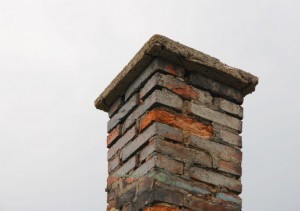As the temperatures drop, many families retreat indoors to escape the harsh winter weather. And while some homeowners take steps to protect their fireplaces and chimneys against the cold, many do not realize that all masonry structures can be damaged by the cold, ice, and snow.
In addition to taking precautionary measures to protect the masonry on their chimneys, homeowners should consider ways to protect the bricks and mortar in other structures such as exterior walls, fences, or archways. This masonry work can be just as effected by winter weather as chimneys, yet is often left unprotected.
The freeze thaw process
The primary way that masonry structures can be damaged is by the freeze thaw process. The freeze thaw process is caused by water entering small holes or cracks in the brick. As the temperature drops, this water freezes and expands. As it thaws, the brick is left with even larger areas of damage, allowing more water in. This process continues as the brick becomes progressively more damaged.
Damage to masonry
Damage to masonry structures can be caused by several contributing factors to the freeze thaw process:
Spalled bricks: Spalling is the most common and most visible sign of masonry damage. It occurs when water damage has gone unrepaired over a long period of time, causing the bricks and mortar to crack, crumble, flake, or fall away. In severe cases of spalling, a masonry structure will simple crumble and fall away.
Brick arches are especially susceptible to collapse due to spalling. As the arch is held in place by the pressure of the masonry, any damage to the bricks can cause this delicate balance of bricks to shift and collapse.
Damage from pressure washing: Many homeowners pressure wash their masonry structures and surfaces each year as a way to keep them clean and free from moss and dirt. What they may not realize, however, is that the use of pressure washers or sandblasters can create small cracks and indentations in the bricks and mortar. These tiny holes can then fill with water, freeze, and expand, further damaging the masonry through the freeze thaw process.
Use of the wrong bricks: Not all bricks are created equal. Homeowners attempting to patch or replace broken or missing bricks in a masonry structure often don’t know which kind of bricks and mortar to use. Because of this, the replacement bricks may not be as strong or installed as well as their surrounding counterparts. This is especially true when using salvaged or recycled bricks, which may not have been designed to withstand the weather in your area. To ensure that replacement bricks and mortar are the right fit for your region and climate, have all masonry repairs professionally completed.
Preventing masonry damage
There are a number of ways that homeowners can prevent damage to their masonry structures. Once of the easiest and most cost effective methods for protecting your bricks and mortar is by having them professionally waterproofed. This process uses specially designed sealants that allow the masonry to retain its porous nature while still preventing water from getting into the bricks and mortar. These products can even be used on masonry structures with existing spalling or other damage.
If you have questions about how to prevent winter weather damage to your masonry chimney, path, arch, or other structure, contact New Buck Chimney today. Our expert technicians can help prepare your masonry structures for the cold months ahead, keeping them beautiful, functional, and strong for years to come.

